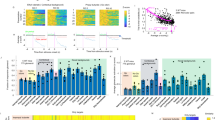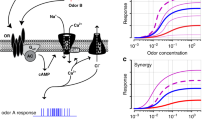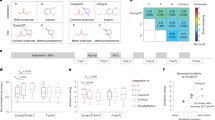Abstract
In odorant-rich environments, animals must be able to detect specific odorants of interest against variable backgrounds. However, studies have found that both humans and rodents are poor at analyzing the components of odorant mixtures, suggesting that olfaction is a synthetic sense in which mixtures are perceived holistically. We found that mice could be easily trained to detect target odorants embedded in unpredictable and variable mixtures. To relate the behavioral performance to neural representation, we imaged the responses of olfactory bulb glomeruli to individual odors in mice expressing the Ca2+ indicator GCaMP3 in olfactory receptor neurons. The difficulty of segregating the target from the background depended strongly on the extent of overlap between the glomerular responses to target and background odors. Our study indicates that the olfactory system has powerful analytic abilities that are constrained by the limits of combinatorial neural representation of odorants at the level of the olfactory receptors.
This is a preview of subscription content, access via your institution
Access options
Subscribe to this journal
Receive 12 print issues and online access
$209.00 per year
only $17.42 per issue
Buy this article
- Purchase on Springer Link
- Instant access to full article PDF
Prices may be subject to local taxes which are calculated during checkout






Similar content being viewed by others
References
Apfelbach, R., Blanchard, C.D., Blanchard, R.J., Hayes, R.A. & McGregor, I.S. The effects of predator odors in mammalian prey species: a review of field and laboratory studies. Neurosci. Biobehav. Rev. 29, 1123–1144 (2005).
Howard, W.E., Marsh, R.E. & Cole, R.E. Food detection by deer mice using olfactory rather than visual cues. Anim. Behav. 16, 13–17 (1968).
Blaustein, A.R. Sexual selection and mammalian olfaction. Am. Nat. 117, 1006–1010 (1981).
Crouzet, S.M. & Serre, T. What are the visual features underlying rapid object recognition? Front. Psychol. 2, 326 (2011).
Wolfson, S.S. & Landy, M.S. Examining edge- and region-based texture analysis mechanisms. Vision Res. 38, 439–446 (1998).
Elhilali, M. & Shamma, S.A. A cocktail party with a cortical twist: how cortical mechanisms contribute to sound segregation. J. Acoust. Soc. Am. 124, 3751–3771 (2008).
McDermott, J.H. The cocktail party problem. Curr. Biol. 19, R1024–R1027 (2009).
Jinks, A. & Laing, D.G. A limit in the processing of components in odour mixtures. Perception 28, 395–404 (1999).
Laing, D.G. & Francis, G.W. The capacity of humans to identify odors in mixtures. Physiol. Behav. 46, 809–814 (1989).
Jinks, A. & Laing, D.G. The analysis of odor mixtures by humans: evidence for a configurational process. Physiol. Behav. 72, 51–63 (2001).
Wilson, D.A. & Stevenson, R.J. Olfactory perceptual learning: the critical role of memory in odor discrimination. Neurosci. Biobehav. Rev. 27, 307–328 (2003).
Hopfield, J.J. Odor space and olfactory processing: collective algorithms and neural implementation. Proc. Natl. Acad. Sci. USA 96, 12506–12511 (1999).
Polak, E.H. Multiple profile-multiple receptor site model for vertebrate olfaction. J. Theor. Biol. 40, 469–484 (1973).
Koulakov, A., Gelperin, A. & Rinberg, D. Olfactory coding with all-or-nothing glomeruli. J. Neurophysiol. 98, 3134–3142 (2007).
Giraudet, P., Berthommier, F. & Chaput, M. Mitral cell temporal response patterns evoked by odor mixtures in the rat olfactory bulb. J. Neurophysiol. 88, 829–838 (2002).
Shen, K., Tootoonian, S. & Laurent, G. Encoding of mixtures in a simple olfactory system. Neuron 10.1016/j.neuron.2013.08.026 (2013).
Tabor, R., Yaksi, E., Weislogel, J.-M. & Friedrich, R.W. Processing of odor mixtures in the zebrafish olfactory bulb. J. Neurosci. 24, 6611–6620 (2004).
Arnson, H.A. & Holy, T.E. Robust encoding of stimulus identity and concentration in the accessory olfactory system. J. Neurosci. 33, 13388–13397 (2013).
Frederick, D.E., Barlas, L., Ievins, A. & Kay, L.M. A critical test of the overlap hypothesis for odor mixture perception. Behav. Neurosci. 123, 430–437 (2009).
Laska, M. & Hudson, R. Discriminating parts from the whole: determinants of odor mixture perception in squirrel monkeys, Saimiri sciureus. J. Comp. Physiol. A 173, 249–256 (1993).
Wiltrout, C., Dogra, S. & Linster, C. Configurational and nonconfigurational interactions between odorants in binary mixtures. Behav. Neurosci. 117, 236–245 (2003).
Kay, L.M., Crk, T. & Thorngate, J. A redefinition of odor mixture quality. Behav. Neurosci. 119, 726–733 (2005).
Wilson, D.A. Pattern separation and completion in olfaction. Ann. NY Acad. Sci. 1170, 306–312 (2009).
Barnes, D.C., Hofacer, R.D., Zaman, A.R., Rennaker, R.L. & Wilson, D.A. Olfactory perceptual stability and discrimination. Nat. Neurosci. 11, 1378–1380 (2008).
Linster, C., Henry, L., Kadohisa, M. & Wilson, D.A. Synaptic adaptation and odor-background segmentation. Neurobiol. Learn. Mem. 87, 352–360 (2007).
Saha, D. et al. A spatiotemporal coding mechanism for background-invariant odor recognition. Nat. Neurosci. 16, 1830–1839 (2013).
Abraham, N.M. et al. Maintaining accuracy at the expense of speed: stimulus similarity defines odor discrimination time in mice. Neuron 44, 865–876 (2004).
Rinberg, D., Koulakov, A. & Gelperin, A. Speed-accuracy tradeoff in olfaction. Neuron 51, 351–358 (2006).
Uchida, N. & Mainen, Z.F. Speed and accuracy of olfactory discrimination in the rat. Nat. Neurosci. 6, 1224–1229 (2003).
Zariwala, H.A., Kepecs, A., Uchida, N., Hirokawa, J. & Mainen, Z.F. The limits of deliberation in a perceptual decision task. Neuron 78, 339–351 (2013).
Grossman, K.J., Mallik, A.K., Ross, J., Kay, L.M. & Issa, N.P. Glomerular activation patterns and the perception of odor mixtures. Eur. J. Neurosci. 27, 2676–2685 (2008).
Secundo, L., Snitz, K. & Sobel, N. The perceptual logic of smell. Curr. Opin. Neurobiol. 25, 107–115 (2014).
Ma, L. et al. Distributed representation of chemical features and tunotopic organization of glomeruli in the mouse olfactory bulb. Proc. Natl. Acad. Sci. USA 109, 5481–5486 (2012).
McGann, J.P. et al. Odorant representations are modulated by intra- but not interglomerular presynaptic inhibition of olfactory sensory neurons. Neuron 48, 1039–1053 (2005).
Meister, M. & Bonhoeffer, T. Tuning and topography in an odor map on the rat olfactory bulb. J. Neurosci. 21, 1351–1360 (2001).
Soucy, E.R., Albeanu, D.F., Fantana, A.L., Murthy, V.N. & Meister, M. Precision and diversity in an odor map on the olfactory bulb. Nat. Neurosci. 12, 210–220 (2009).
Uchida, N., Takahashi, Y.K., Tanifuji, M. & Mori, K. Odor maps in the mammalian olfactory bulb: domain organization and odorant structural features. Nat. Neurosci. 3, 1035–1043 (2000).
Isogai, Y. et al. Molecular organization of vomeronasal chemoreception. Nature 478, 241–245 (2011).
Fletcher, M.L. Analytical processing of binary mixture information by olfactory bulb glomeruli. PLoS ONE 6, e29360 (2011).
Lin, D.Y., Shea, S.D. & Katz, L.C. Representation of natural stimuli in the rodent main olfactory bulb. Neuron 50, 937–949 (2006).
Kass, M.D., Moberly, A.H., Rosenthal, M.C., Guang, S.A. & McGann, J.P. Odor-specific, olfactory marker protein-mediated sparsening of primary olfactory input to the brain after odor exposure. J. Neurosci. 33, 6594–6602 (2013).
Abraham, N.M., Vincis, R., Lagier, S., Rodriguez, I. & Carleton, A. Long term functional plasticity of sensory inputs mediated by olfactory learning. Elife 3, e02109 (2014).
Jones, S.V., Choi, D.C., Davis, M. & Ressler, K.J. Learning-dependent structural plasticity in the adult olfactory pathway. J. Neurosci. 28, 13106–13111 (2008).
Treisman, A.M. & Gelade, G. A feature-integration theory of attention. Cognit. Psychol. 12, 97–136 (1980).
Chapuis, J. & Wilson, D.A. Bidirectional plasticity of cortical pattern recognition and behavioral sensory acuity. Nat. Neurosci. 15, 155–161 (2012).
Choi, G.B. et al. Driving opposing behaviors with ensembles of piriform neurons. Cell 146, 1004–1015 (2011).
Haberly, L.B. Parallel-distributed processing in olfactory cortex: new insights from morphological and physiological analysis of neuronal circuitry. Chem. Senses 26, 551–576 (2001).
Boyd, A.M., Sturgill, J.F., Poo, C. & Isaacson, J.S. Cortical feedback control of olfactory bulb circuits. Neuron 76, 1161–1174 (2012).
Markopoulos, F., Rokni, D., Gire, D.H. & Murthy, V.N. Functional properties of cortical feedback projections to the olfactory bulb. Neuron 76, 1175–1188 (2012).
Brody, C.D. & Hopfield, J.J. Simple networks for spike-timing-based computation, with application to olfactory processing. Neuron 37, 843–852 (2003).
Koulakov, A.A. & Rinberg, D. In search of the structure of human olfactory space. Front. Syst. Neurosci. 5, 65 (2011).
Acknowledgements
We thank N. Uchida, R. Wilson and members of our laboratory for comments on the manuscript. Work in V.N.M.'s laboratory was supported by grants from the US National Institutes of Health (RO1DC11291). D.R. was supported by a fellowship from the Edmond and Lily Safra Center for Brain Sciences, Hebrew University.
Author information
Authors and Affiliations
Contributions
D.R. and V.N.M. conceived and designed the experiments. D.R. and V.H. collected the behavioral data. V.K. collected the imaging data. D.R. analyzed the behavioral data. D.R. and V.K. analyzed the imaging data. D.R. and V.N.M. wrote the manuscript.
Corresponding author
Ethics declarations
Competing interests
The authors declare no competing financial interests.
Integrated supplementary information
Supplementary Figure 1 Olfactometer for behavioral experiments.
A custom built olfactometer was used to deliver mixtures of odorants to the mouse. The olfactometer was designed to allow each of the 16 odorants to be present or absent in any mixture while keeping the concentration of each odorant independent of other odorants. a. To achieve this goal, the olfactometer was built with 16 modules, each controlling one odorant and contributing a constant and equal amount to the output flow. Input flow into the modules and output flow from the modules were made using FEP-lined Tygon/PVC tubing connected in symmetric pair-wise bifurcations. Each module had a 3-way valve (Lee Company, USA) that diverted the input flow of clean air to go through either of two glass tubes, one containing the odor and solvent and one containing only the solvent. Both pathways then converged to form the module output flow. From the point where all odorants converged to the odor port, the odorous air flowed through a 4 foot long tubing of 1/16 inch diameter. This minimized the latency from valve opening to odor presentation and ensured mixing of the odorants to at least within the scale of the tubing. Odorant mixtures were generated by controlling the 16 module valves allowing 216 possible mixtures. b. Photoionization detector (miniPID, Aurora Scientific) measurements were used to analyze the output of the olfactometer. The amplitude of the PID signal in response to an odorant mixture was equal to the sum of the amplitudes of PID signals in response to the individual components, indicating that the different odorant modules are independent.
Supplementary Figure 2 Individual mouse performance: tiglate targets.
Performance of individual mice trained to detect tiglate targets. Plots show the percentage of correct trials as a function of the number of components in the mixture for all trials (black), Go trials (blue) and NoGo trials (red). Lines are linear fits to the data. Targets were Ethyl tiglate and Allyl tiglate (a and h), Benzyl tiglate and Phenylethyl tiglate (b, c, f and g), Hexyl tiglate and Methyl tiglate (d), and Isopropyl tiglate and citronellyl tiglate (e).
Supplementary Figure 3 Individual mouse performance: non-tiglate targets.
Performance of individual mice trained to detect non-tiglate targets. Plots show the percentage of correct trials as a function of the number of components in the mixture for all trials (black), Go trials (blue) and NoGo trials (red). Lines are linear fits to the data. Targets were Ethyl propionate and 2-Ethyl hexanal (a), Propyl acetate and 4-Allyl anisole (b), Isobutyl propionate and Allyl butyrate (c), and Ethyl valerate and Citronellal (d and e).
Supplementary Figure 4 Individual mouse performance: population averages.
a-c. Performance as a function of the number of components in the mixture for all mice (a, n=13), tiglate trained mice (b, n=8) and non-tiglate trained mice (c, n=5). Here data are only pooled within each mouse and then averaged across mice. Shown are mean±SE for all trials (black), Go trials (blue), and NoGo trials (red). Lines are linear fits to the data. d. The effect of tiglates and non-tiglates as background odorants on the performance of all individual mice detecting tiglates (left) and mice detecting non-tiglates (right). Group effects were calculated as the average change in % correct rejections when an odorant of the group is added to the background (see Figure 3). The lines are connecting data of individual mice. Colored dots are the mean effect of each group.
Supplementary Figure 5 Estimation of mixture responses as maximal intensity projection of individual components.
a and d. Percent of NoGo trials that were correctly rejected as a function of mixture masking (a) and target-mixture correlation (d) (top panels). Each data point represents 500 trials. Red lines are fits of sigmoidal decay to the data (see methods). Below are shown the distributions of masking and correlation values for all mixtures presented in NoGo trials. b and e. Average number of components in the mixture as a function of mixture masking (b) and target-mixture correlation (e). c and f. Percent of NoGo trials with fixed number of components in the mixture that were correctly rejected as a function of mixture masking (c) and target-mixture correlation (f). Each curve shows the data from a fixed number of components in the mixture (indicated by color). Symbols show the average percent of correct rejections.
Supplementary Figure 6 Robustness of masking analysis.
Masking was calculated as in Figure 6b, but the threshold for glomerular responses was varied from 1 to 15 standard deviations away from the baseline. Masking index was a good predictor of performance throughout this range, indicating that the results are insensitive to thresholding. Each data point represents the mean values of 500 trials. Red lines are fits of sigmoidal decay to the data (see Online Methods).
Supplementary information
Supplementary Text and Figures
Supplementary Figures 1–6 (PDF 2204 kb)
Rights and permissions
About this article
Cite this article
Rokni, D., Hemmelder, V., Kapoor, V. et al. An olfactory cocktail party: figure-ground segregation of odorants in rodents. Nat Neurosci 17, 1225–1232 (2014). https://doi.org/10.1038/nn.3775
Received:
Accepted:
Published:
Issue Date:
DOI: https://doi.org/10.1038/nn.3775
This article is cited by
-
Robust odor identification in novel olfactory environments in mice
Nature Communications (2023)
-
Odour hedonics and the ubiquitous appeal of vanilla
Nature Food (2022)
-
Active sensing in a dynamic olfactory world
Journal of Computational Neuroscience (2022)
-
The scent of attraction and the smell of success: crossmodal influences on person perception
Cognitive Research: Principles and Implications (2021)
-
Fast odour dynamics are encoded in the olfactory system and guide behaviour
Nature (2021)



